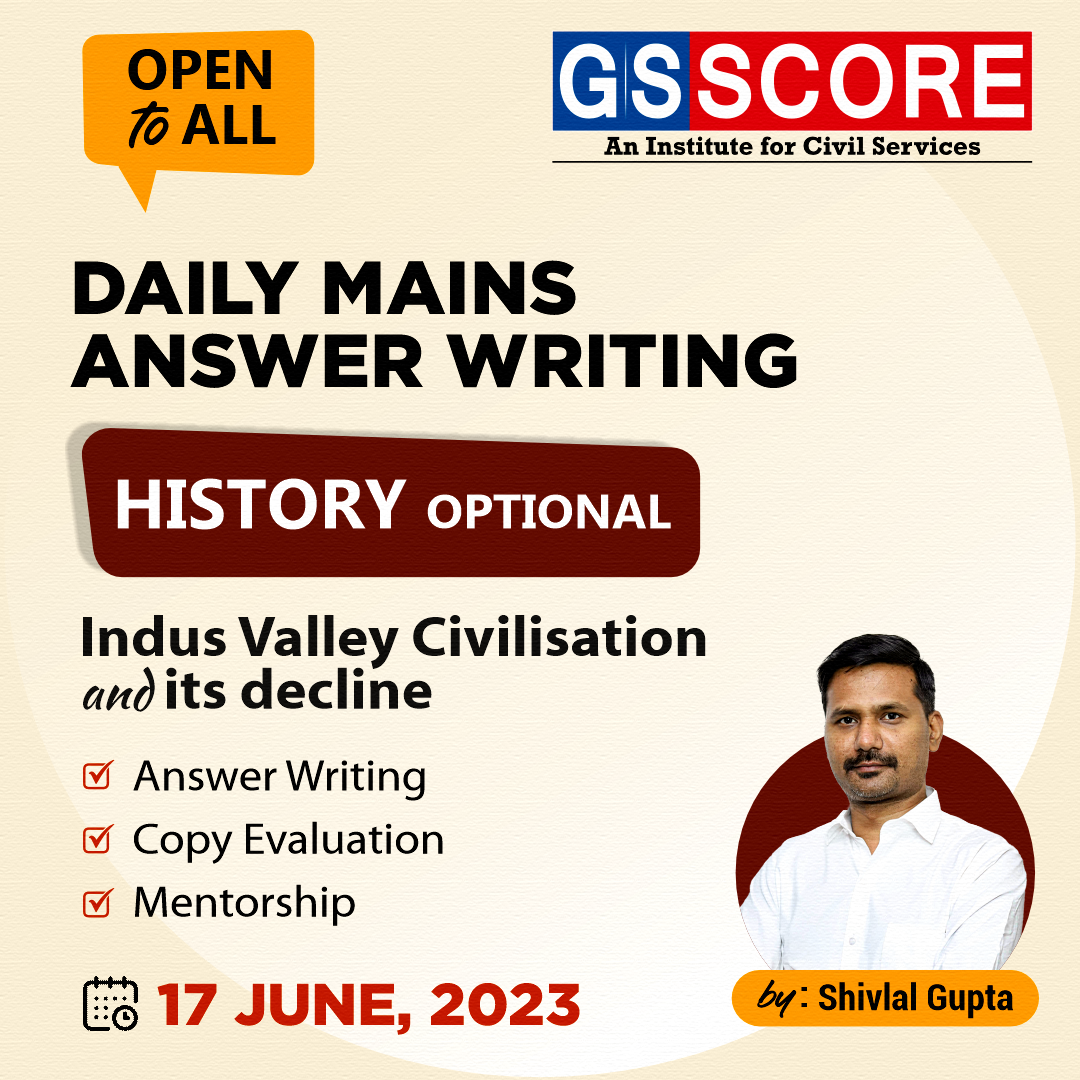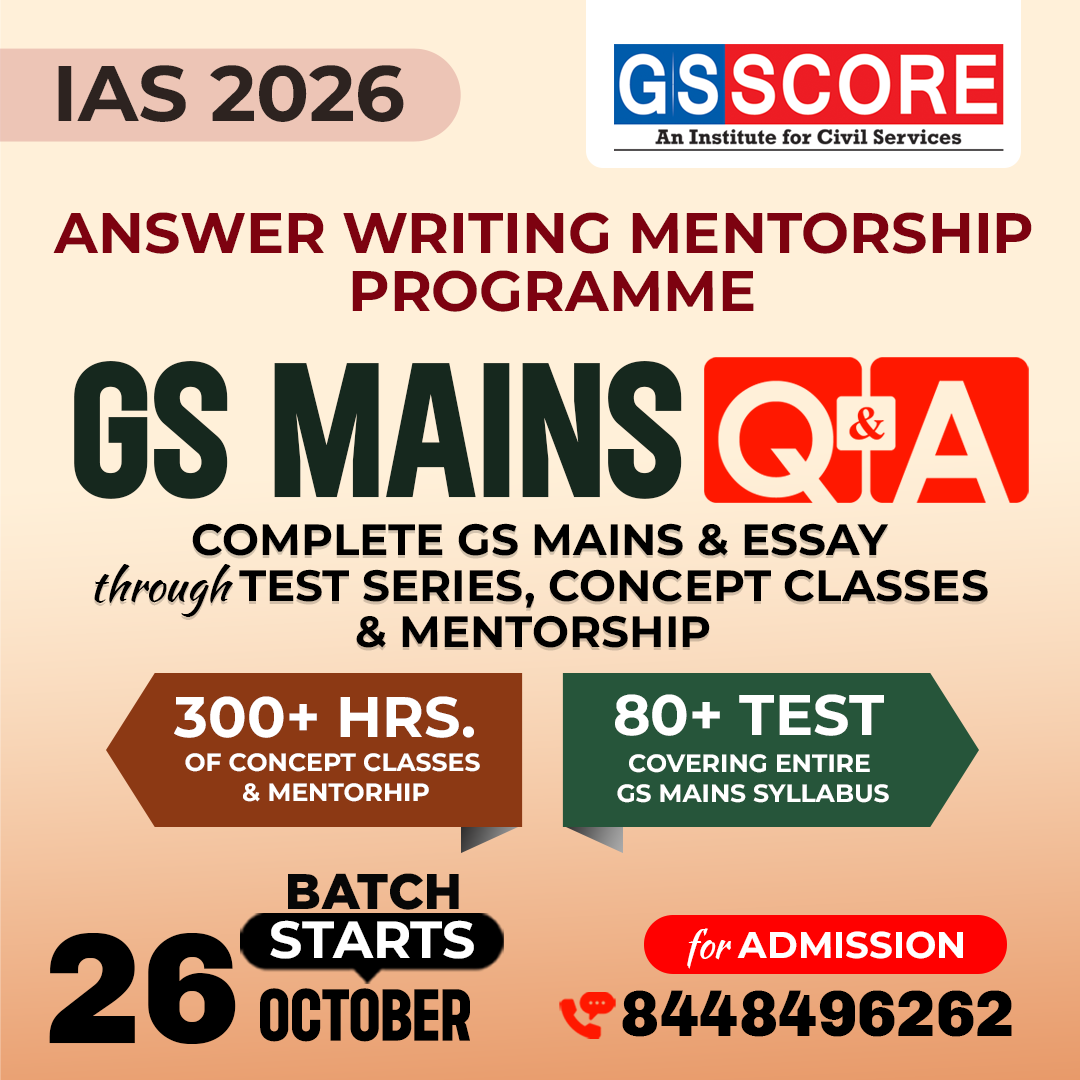


Instruction:
- There will be 2 questions carrying 10 marks each. Write your answers in 150 words
- Any page left blank in the answer-book must be crossed out clearly.
- Evaluated Copy will be re-uploaded on the same thread after 2 days of uploading the copy.
- Discussion of the question and one to one answer improvement session of evaluated copies will be conducted through Google Meet with concerned faculty. You will be informed via mail or SMS for the discussion.
Question #1. "Throw light on the debate over the nature of political system & kind of state existed in Harappan civilisation."
Question #2. Origin of Harappan Civilisation can be best explained by Indigenous Evolution rather than Diffusion? Comment.
(Examiner will pay special attention to the candidate's grasp of his/her material, its relevance to the subject chosen, and to his/ her ability to think constructively and to present his/her ideas concisely, logically and effectively).
STEPS & INSTRUCTIONS for uploading the answers
Step 1 - The Question for the day is provided below these instructions. It will be available at 7:00 AM.
Step 2 - Uploading of Answers : Write the answer in A4 Sheet leaving proper margins for comments and feedback and upload the PDF in MY ACCOUNT section. Click on the option of SUBMIT COPY to upload the PDF.
Step 3 - Deadline for Uploading Answers: The students shall upload their answers by 7:00 PM in the evening same day. The first 50 copies will be evaluated.
Step 4 - Feedback : Mentors will give their feedback for the answers uploaded. For more personalised feedback, join our telegram channel by clicking on the link https://t.me/mains_answer_writing_cse . A one-to-one session will be conducted with the faculty after copy evaluation in 72 Hrs.
Model Answer
Question #1. "Throw light on the debate over the nature of political system & kind of state existed in Harappan civilisation."
Introduction:
The similarity in the design of cities, apart from the uniform sized seals and burnt bricks found in the Harappan civilization, the common components of the culture, ensure that a political power must have existed for the smooth functioning of such a vast and vibrant civilization.
Body:
- Historians differ as to the nature of the political power that governed the Harappan civilization.
- Apart from this, the other important question is that in which class was the political power, was the leadership single or collective, how did the bureaucracy work.
- Other issues are: Did it consist of a single empire? Were there different kingdoms that were following a common ideology? Was the civilization at the level of a state or chiefdom?
- J. Jacobson states that the civilization shows ‘state level of socio-cultural integration’ as seen from cultural and perhaps linguistic uniformity achieved over a large area, standardisation of planning and others.
- According to Wheeler and Stuart Piggot, it was one empire ruled by autocratic priest kings helped by an efficient bureaucracy.
- Other historians regard the religious ideology of the state as the focal point of power and believe that centralised rule needs military enforcement and a standing army.
- According to W. Fairservis and S C Malik , Harappan cities lack military character so the impressive uniformity of the cities could have been due to a religious ideology. Fairservis has even advocated a village-like authority regulating the cities.
However other scholars believe that this uniformity could have been achieved through the needs of internal trade rather than political authority.
- M. Kenoyer has divided the political authority into 2 parts: state-level and chiefdom-level
- The polities with larger settlements being at the state-level and the smaller settlements in remote areas being at the level of the chiefdom.
- He further argues that urban settlements like Harappa, Mohenjodaro, Rakhigarhi and Ganeriwala could have been independent city-states with several urban elites competing for power.
- However, in terms of polity it may have been at an early state level as seen in its weak military component and weak level of stratification.
- At the top of the pyramid of the Harappan society were three invisible categories of people-the administrators, the traders and the priests.
- Their presence can be presumed on the basis of an understanding of the problems of the organisation.
- In the Harappan civilization we can perceive the presence of a decision-making authority for running the municipal system: The construction and maintenance of 'elaborate drainage system and streets would require a municipal authority in the cities.
- Similarly, the granaries indicate the presence of an authority which would collect food grains from the surrounding hinterland and redistribute it among the citizens.
- The tools, weapons, bricks etc. show a remarkable uniformity of design. Some of the tools and weapons seem to have been mass-produced in one place and then distributed to various cities and settlements. .
- The organisation of production and distribution of these objects over an area covering thousands of kms would give tremendous power to those who decided how much to produce and where to send the products. If these people were to stop the supply of goods to a particular town, that town would be starved of tools and implements.
- The sheer range and volume of products consumed by the residents of the large cities indicate that some kind of a ruling class resided in them.
- Many of the objects were rarities brought from faraway lands. The possession of such precious stones or metals would give immense prestige to owners vis-a-vis the rest of the' population.
- Similarly, the larger size of the cities did not simply indicate that a larger number of people lived there but also the fact that they contained many monumental structures like temples, palaces etc.
- The people who lived in these structures exercised political or economic or religious authority.
- The seals which are considered marks of authority of traders, priests or administrators are found in largest numbers in Mohenjodaro where the largest number of monumental structures has also been found.
- However, historians are not sure that Mohenjodaro functioned as the Capital of the Harappan Civilization. It is possible that the Harappan Civilization consisted of two to five independent political units.
- This means that the same person could be the head priest, king and the wealthiest merchant. But all these evidence indicates the presence of a ruling authority. What was the form of this authority is not yet clear to us.
Conclusion:
The rise of Civilization is associated with the emergence of a centralised decision-making system called the State.
It is clear that cities had emerged as the Centre of politico-economic power in the Harappan Civilization but we do not know who the rulers of the Harappans may have been kings, priests or traders. However, in many pre-modern societies the economic, religious and administrative spheres are not clearly demarcated.
Question #2. Origin of Harappan Civilisation can be best explained by Indigenous Evolution rather than Diffusion? Comment.
Approach
- The question focuses on 2 pillars of 1) Origin of Harappan Civilisation due to Indigenous Evolution 2) Origin of Harappan Civilisation due to Diffusion theory.
- The perspective of the question demand critical views of the aspirants on the Origin of Harappan Civilisation.
- Introduction (Summary of key demand of the question, along with necessary facts).
- Conclusion by summing up the gist of the answer.
The Harappan Civilisation was a Bronze Age civilisation in the northwestern regions of South Asia, lasting from 3300 BCE to 1300 BCE, and in its mature form from 2600 BCE to 1900 BCE.Together with ancient Egypt and Mesopotamia, it was one of three early civilisations of the Near East and South Asia, and of the three, the most widespread, its sites spanning an area stretching from today's northeast Afghanistan, through much of Pakistan, and into western and northwestern India. Issues of origins are always complex and often contentious.
Origin of Harappan Civilisation due to Diffusion :
- According to E. J. H. Mackay, a migration of people from Sumer (southern Mesopotamia) may have led to the Harappan civilization; other proponents of the migration theory included D.H. Gordon and S. N. Kramer. Mortimer Wheeler argued for a migration of ideas, not people—the idea of civilization was in the air of West Asia in the 3rd millennium BCE and the founders of the Harappan civilization had a model of civilization before them.
- However,the fact that city life emerged in Mesopotamia a few centuries before it appeared in the Egyptian and Harappan contexts does not mean that the latter were derived from the former in a direct or indirect way. There are in fact several striking differences between the Harappan and Mesopotamian civilizations. The Mesopotamians had a completely different script, a much greater use of bronze, different settlement layouts, and a large-scale canal system of the kind that seems absent in the Harappan civilization.
Origin of Harappan Civilisation due to Indigenous Evolution:
- The story of its origins can, in fact, be traced to the emergence of settled farming communities in Baluchistan in the 7th millennium BCE. Its more immediate prelude was the cultural phase that used to be known as pre-Harappan, and is now usually referred to as the early Harappan phase.
- Amalananda Ghosh was the first archaeologist to identify similarities between a pre-Harappan culture and the mature Harappan culture. Ghosh focused on the pre-Harappan Sothi culture of Rajasthan. He asserted that there were similarities between Sothi pottery and the pottery of (a)Zhob, Quetta, and other Baluchi sites; (b) pre-Harappan Kalibangan, Kot Diji, and the lowest levels of Harappa and Mohenjodaro; and (c) mature Harappan levels at Kalibangan, and perhaps also at Kot Diji. In view of these similarities, he argued that the Sothi culture should be described as proto-Harappan. A limitation of this hypothesis was that it was based exclusively on a comparison of pottery, and did not consider other material traits. And in emphasizing ceramic similarities, Ghosh had ignored the many differences between the Sothi and Harappan cultures.
The first comprehensive analysis of the evidence from pre-Harappan sites in the greater Indus valley and north Baluchistan was made by M. R. Mughal . Mughal compared the whole range of evidence (pottery, stone tools, metal artefacts, architecture, etc.) from pre-Harappan and mature Harappan levels, and explored the relationship between the two stages.


